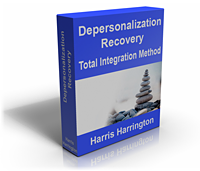Harris Harrington explains why certain people acquire the disorder.

By Harris Harrington
This is a complicated issue, but if I were to give the simplest one sentence answer with current research in mind it would be this: Depersonalization is caused by a disorganized attachment style, emotional abuse, accumulated trauma, an acute trigger, and obsessive thought processes. To put that in language most people understand, Depersonalization is caused by extremely high levels of stress, which causes a person to dissociate in order to avoid psychic pain.
But why do some people dissociate during high stress and others don’t?
According to research done by Giovanni Liotti, MD, and Italian psychologist, a predisposition to dissociation during high stress is caused by a disorganized attachment style acquired during infancy.
What exactly is disorganized attachment?
In order to answer that question let me first explain attachment theory and attachment styles, followed by a discussion of how this pattern of thinking, feeling, and behaving is reinforced by future emotional abuse and dysfunctional family rules.
Attachment theory, one of the most rigorously studied areas of developmental psychology, holds that “human beings are endowed with a strong, inborn, evolved disposition to seek help, care, and comfort from a familiar member of their social group. This disposition is activated whenever human beings experience physical or emotional pain, and whenever they, through the emotion of fear, perceive themselves vulnerable in the face of danger” (Liotti).
Infants are born with what is called an “attachment behavioral system”, which means they seek proximity, emotional support, physical support and social support from a primary caregiver.
The purpose of the attachment behavioral system is to instill inside the infant “felt security”. When the child feels safe, comforted, and soothed, it knows it is safe from danger.
In order for a child to acquire this state of felt security on a routine basis the primary caregiver must respond to the child consistently, with proper emotional attunement and attention to the child’s needs. If a caregiver provides this quality of support, the child will develop a “secure” attachment style.
If the caregiver is consistently negligent toward the infant, the infant will suppress the attachment system and develop what is called an avoidant attachment style.
If the caregiver is inconsistently supportive of the child, the child will chronically hyperactivate the attachment system, creating ambivalent/preoccupied attachment.
If the caregiver appears either frightening to the child, or frightened of the child, the child will experience fear without escape and will develop a disorganized/unresolved attachment style.
In essence, when a parent is either outright abusive to the child, or is frightened of the child, the child will experience fear when approaching the attachment figure. The attachment figure is supposed to act as a safe haven where the child can acquire felt security.
Disorganized attachment represents a breakdown in the attachment behavioral system. The reason is that the behavior of the parent elicits both the attachment behavioral system and the fight or flight system. Since the purpose of the fight or flight system is run or flee from danger, and the purpose of the attachment system is to seek felt security. These two behavioral system have two simultaneously incompatible goals.
An infant with a disorganized attachment system is a person who experiences fear when their attachment needs are triggered. Remember, our attachment behavioral system is activated under any period of intense stress.
The result of disorganized attachment is a number of ego states, which are mutually incompatible cognitive-affective-behavioral strategies for understanding and relating to the interpersonal world when in a state of need.
The three primary ego states are the victim, rescuer, and persecutor. When an infant with disorganized attachment grows into an adult, he or she will have a tendency to “split” into different ego states when his or her attachment needs are triggered.
What this means is that, any time a person with disorganized attachment experiences interpersonal conflict, he is going to enter into these three primary ego states (self states), because he cannot properly deal with the conflict in a coherent manner. He will feel like a victim, usually at the outset of an interpersonal conflict, and when he hits a threshold of thoughts of himself as a persecutor, he will enter the persecutor state of mind. He will then feel like a rescuer once the conflict resolves.
This inability to process attachment needs in a coherent way causes in a person a predisposition to acquiring a disorder on the dissociative spectrum, such as Borderline Personality Disorder (BPD), Multiple Personality Disorder (MPD), and of course Depersonalization Disorder (DPD).
This is the reason why not everyone acquires depersonalization under high periods of stress.
The infant with disorganized attachment feels “pain without solution” when facing the parent, and a person about to depersonalize in the face of high stress enters into “the escape when there is no escape”.
In order to counteract this aspect of depersonalization, I show people in my program Depersonalization Recovery: Total Integration Method, how to acquire what is called an “earned secure base”. Earned security is when someone who had an insecure or disorganized attachment pattern subsequently learns how to think, feel, and behave in a way similar to a person born with a secure attachment style.
My whole program can be conceptualized as a training program in showing you how to develop security and a strong, resilient sense of self in the face of stress. I show you how to mend the victim, persecutor, and rescuer ego states so that dissociation is no longer necessary when you are in a state of high stress. By being able to handle stress with a solid sense of self, you will get rid of DP.
But this isn’t a complete picture of the pathogenesis of DP.
Studies have found that emotional abuse is highly correlated with developing Depersonalization Disorder. Emotional abuse is one of the most misunderstood forms of abuse, since it is subtle and doesn’t leave any lasting visible marks. It only leaves marks on a person’s psyche. Forms of emotional abuse include ignoring, rejecting, isolating, verbally assaulting, exploiting, and terrorizing.
The parents of people with DP most likely have what Nina Brown, author the book Children of the Self-Absorbed calls a “destructive narcissistic pattern”. What this means is that these people don’t properly pay attention to their children, and are self centered in certain ways. The causes the child to adapt his feeling, thinking, and behaving to the parent, and neglecting his own needs for that of the parents. People with DP have trouble focusing on their own needs. They obsess about DP, which is ironically an escape from their emotional needs. These children have what is called co-narcissism. They are addicted to narcissistic people.
Co-narcissistic people suppress their own needs and are passive in social relationships. This emotional suppression correlates with hypo emotionality in brain imaging studies of people with depersonalization. The cortex is overly active, and the emotional centers of the brain (the limbic system) are underactive. Passivity in social relationships can swing to aggressivity if they endure abuse for long enough. People with Depersonalization usually have trouble asserting themselves as a result of this. This passive-aggressive spectrum is related to the shifting of ego states from victim, to persecutor, then back to the rescuer self.
People with DP are also codependent, meaning they are addicted to changing others, which ultimately stems from them not being able to focus on their own needs. Neglectful, and emotionally abusive parents usually invalidate a child’s emotions and sense of self, forcing the child to ignore itself. This causes a weak sense of self left vulnerable to dissociation and depersonalization as a way to cope.
Often times, sufferers of emotional abuse feel like something is wrong, but they are convinced that their childhoods were great. They are often so overcome with guilt and confusion that they blame themselves for their own childhood pain. They have little practice at tending to their own emotional needs, and usually have very few self-nurturing skills. Perfectionism, low self-esteem, loneliness, anxiety, numbness and depression are frequent for such people.
Social isolation and neglect are often elements in the childhoods of people who develop DP. I personally experienced emotional abuse, social isolation, and through all of this I had a disorganized attachment style. I lived for years in a state of denial about my upbringing. Like many people who later acquired DP, my childhood was not physically or sexually abusive. I had my physical needs taken care of, and my parents were around physically, but emotionally and socially I was neglected and isolated. I habitually suppressed my emotional needs and was emotionally abused for decades, primarily by my father, who I felt a false sense of loyalty towards.
When people that have these types of painful backgrounds face stress later in life, they are left with a predisposition to depersonalize, because their minds can’t handle the pain in a fully functional way.
Accumulated trauma is stress that gradually builds up until a pain threshold is met in a person’s psyche. The most intense form of trauma is interpersonal trauma, or stress caused by conflict in relationships.
Dysfunctional family systems that operate under the rules of silence, rigidity, isolation, and denial represent chronic relational trauma. Anyone from a dysfunctional family has experienced chronic trauma and stress. In my family, we couldn’t talk about the dysfunction (workaholism), it was a system that didn’t accommodate change at all (rigid), we had almost no family friends or connection with the outside community (isolated), and whenever I complained about this state of affairs or my emotional needs my parents would deny me (denial). Dysfunctional family systems are caused by parents that have either psychological, religious, or chemical problems that require the thoughts, feelings, and behaviors of all other family members to change. Depersonalization Disorder is mostly found among people from dysfunctional families. I show you how to become aware of these challenges and overcome them in my program.
People with DP may also have been exposed to a traumatic event. I experienced a car accident in which my brother was killed.
In addition to disorganized attachment, emotional abuse, and accumulated trauma, depersonalization is more prevalent in people who engage in obsessive thought loops about the meaning and severity of their symptoms.
For most people, depersonalization is induced by an acute trigger, usually in the form of a panic attack. I acquired DP after a marijuana induced panic attack.
Afterward I obsessed about the symptoms and felt that I was going to go insane. I immediately went to the computer and realized that I had what was called depersonalization disorder. Because what I read online was so bleak, I felt a deep pang of fear that I was going to be stuck in this state forever. In the ensuing months I could not get the feelings out of my mind. I constantly obsessed and ruminated about depersonalization.
I constantly questioned whether or not I was still depersonalized. I checked in every 30 seconds. This obsessive component of depersonalization is very similar to Obsessive-Compulsive Disorder. Another similarity to OCD is that people with DPD constantly ruminate about existential and philosophical questions. This rumination only serves to prolong the disorder.
In order to counteract all of these causes (disorganized attachment, emotional abuse, social isolation, co-dependence, accumulated trauma, and obsessiveness) I direct you to my program Depersonalization Recovery: Total Integration Method, as well as my article “How Do I Cure Depersonalization Disorder?”
